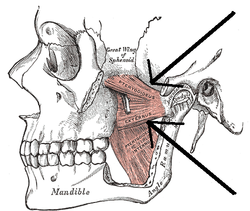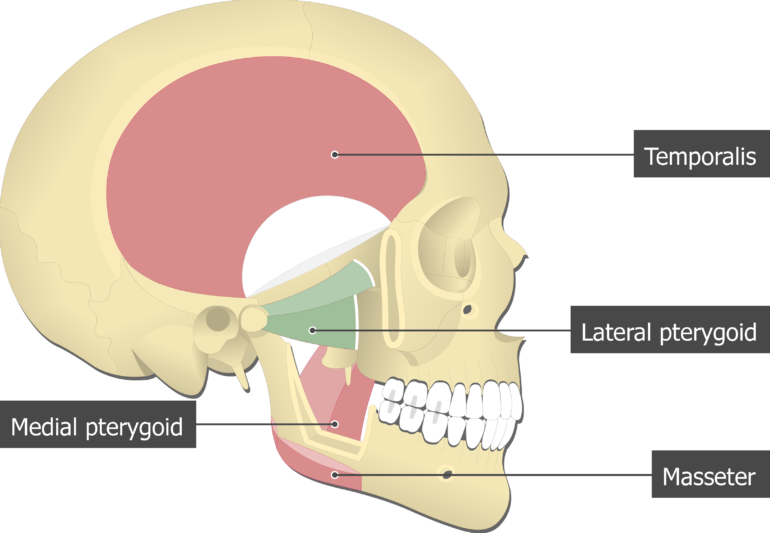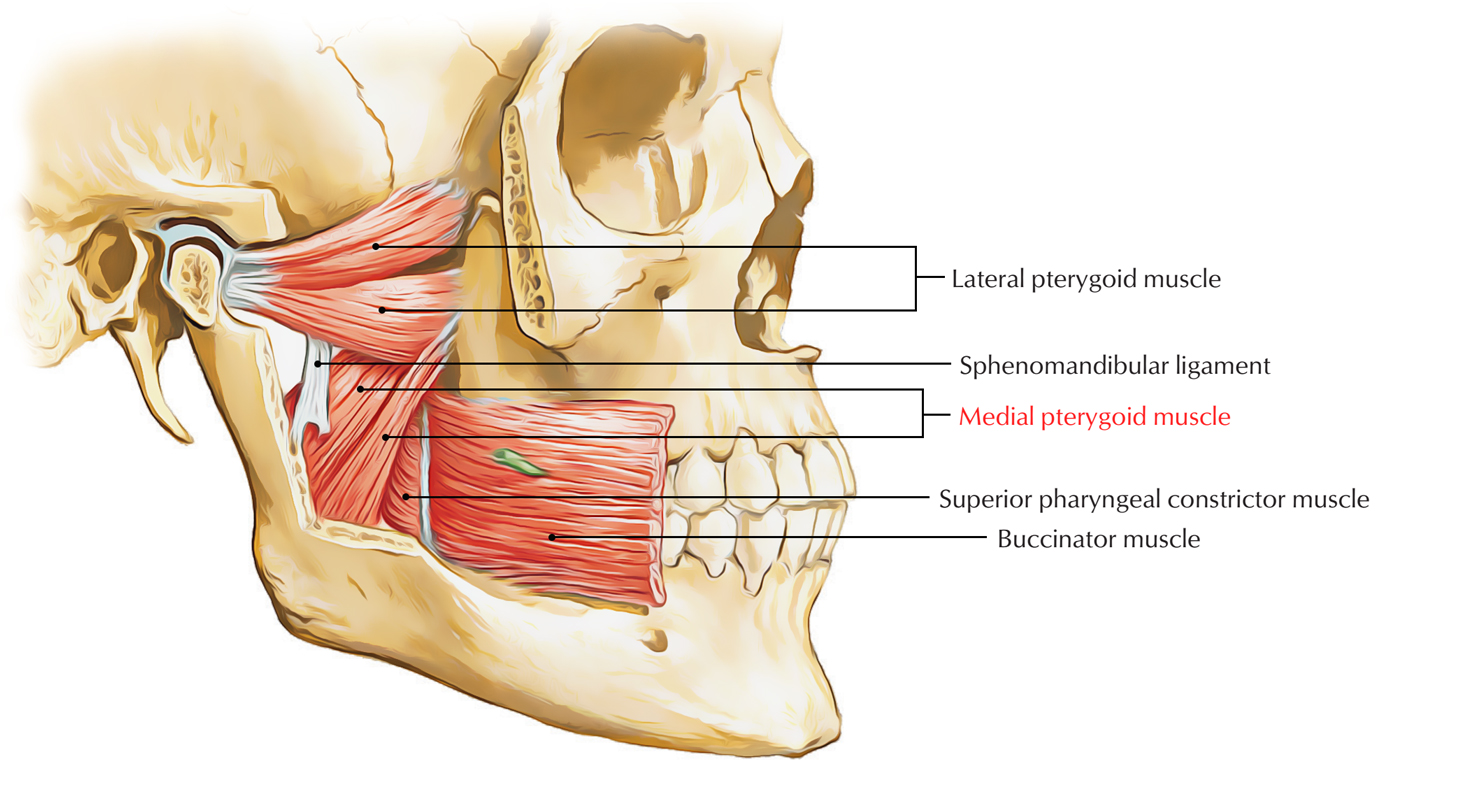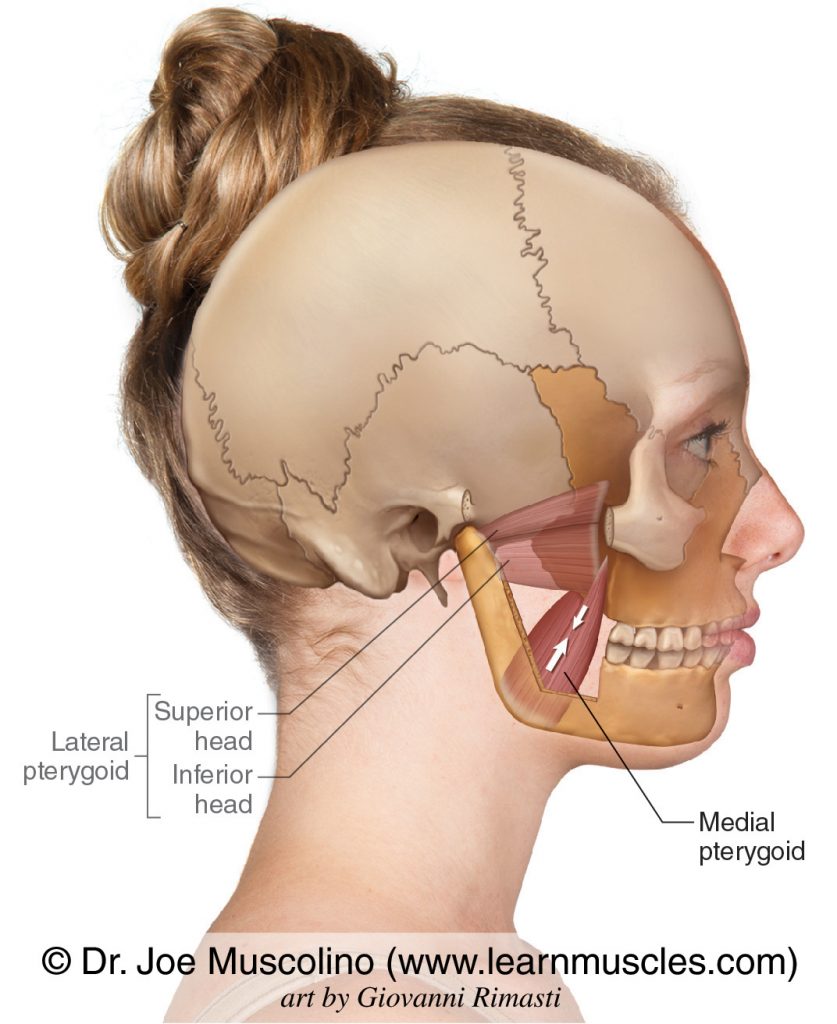The bulk of the muscle arises as a deep head from just above the medial surface of the lateral pterygoid plate. The superficial head of the medial pterygoid muscle originates from the maxillary tuberosity of the maxilla and pyramidal process of the palatine bone.
:background_color(FFFFFF):format(jpeg)/images/library/14110/Pterygoid_muscles.png)
Medial And Lateral Pterygoid Muscle Anatomy And Function Kenhub
The pterygoids are often weak and inactive due to the underdevelopment of the maxilla which causes occlusion to establish too posteriorlyThe pterygoids pro.

. Ive found tension in the temporalises trigger points in the masseters and taut bands in the medial pterygoids. It can assist in protrusion of the mandible. The medial pterygoid muscle has a triple function.
The deep head of the muscle originates from the medial surface of the lateral pterygoid plate of the sphenoid bone. The pterygoid muscles are two of the four muscles of mastication located in the infratemporal foss a of the skull. The medial wall of the infratemporal fossa is embedded within the masticator cavity containing the lateral pterygoid muscle.
The medial pterygoid muscle attaches to the angle of the mandible and to the lateral pterygoid plate to form a sling with the masseter muscle that suspends the mandible Figure 6-19. Medial surface of lateral pterygoid plate and palatine bone. Branches of the mandibular division of the trigeminal nerve CN V3 Blood supply.
It belongs to the group of masticatory muscles along with the lateral pterygoid masseter and temporal muscles. Lateral pterygoid medial pterygoid. A Novel Treatment for Orofacial Pain Med Ultrason.
The medial pterygoid muscle causes pain in the temporomandibular joint and the ear which increases when you bite down on something. It has two heads of origin. The lateral pterygoid muscle is composed of two heads - superior and inferior.
On the lateral side superficial surface the lateral pterygoid muscle relates to the mandibular ramus maxillary artery temporalis tendon and the masseter muscle. Protrusion depression medial movement of mandible. On the medial side deep surface the muscle is related to the mandibular nerve the middle meningeal artery the sphenomandibular ligament and the upper part of the medial pterygoid muscle.
Pterygoid branches of the maxillary artery. Using the medial and lateral pterygoid muscles as references identify the buccal branch of the mandibular nerve CN V3 and accompanying buccal artery. The smaller superior head arises from the infratemporal crest of the greater sphenoid bones higher wing while the larger inferior head emerges from the lateral surface of the lateral pterygoid plate.
The medial pterygoid also elevates the mandible. Although having different origins both heads insert on the inner. Article Media 4 The lateral pterygoid Latin.
The primary action is to elevate the mandible and laterally deviate it to the opposite side. However its possible to eliminate these points and tensions with a self-massage. Medial and Lateral Pterygoids are both well hidden by the lower jaw bone.
Medial pterygoid muscle consists of two heads. Slightly reduced range of opening deviations of mandible with opening altered occlusion my teeth dont fit together right tinnitus are common complaints associated with TrPs in this muscle. The medial pterygoid muscle consists of two heads.
These movements maximize the efficiency of the teeth while chewing or grinding foods of various consistencies. The superficial head is attached to the maxillary tuberosity and the pyramidal process of the palatine bone. Medial surface of ramus and angle of mandible.
The medial pterygoid can be very hyperactive in jaw closing dystonia as a result of the so-called whack-a-mole phenomenon after repeated botulinum toxin injections into the masseter and temporalis muscles. Second unilateral contraction of the medial pterygoid muscle with lateral pterygoid muscle ipsilaterally results in lateral movement of the. It is classified as one of the primary muscles of mastication.
The smaller superficial head originates from the maxillary tuberosity and the pyramidal process of the palatine bone. An upper superior and a lower inferior. Jaw opening jaw deviation and jaw protrusion types of oromamdibular dystonia are caused by involuntary contraction of the lateral pterygoid muscles.
Attachments of Medial Pterygoid Muscle. The lateral pterygoid muscle is a vital component of the inferior temporal region and plays a vital role. The medial pterygoid muscle is a thick and square shaped muscle.
1 The superior. Authors Yunn Jy Chen 1 Pei-Hsuan Chang 2 Ke-Vin Chang 3 Wei-Ting Wu 4 Levent Özçakar 5 Affiliations 1 Department of Dentistry School of. Medial pterygoid muscles arise from the lateral pterygoid plates of the sphenoid bone and insert on the mandible.
Ultrasound Guided Injection for Medial and Lateral Pterygoid Muscles. It helps to have tiny pinky fingers and even then sometimes I need to ask a client to shift their. The deep head is the major component and is attached to the medial aspect of the lateral pterygoid plate of the sphenoid bone.
The lateral pterygoid is a short thick muscle somewhat conical in form which extends almost horizontally posteriorly and laterally between the infratemporal fossa and the condyle of the mandible. It arises by two heads. The medial pterygoid is a muscle of your temporomandibular joint and can cause pain in the jaw throat and ear if it is tense or carries trigger points.
Lateral pterygoid TrPs Refer often severe pain into the maxillary sinus deeply into the TM joint produce dysfunctions of the joint. On this page you will find instructions how to do this. Medial pterygoid is a thick quadrilateral muscle that connects the mandible with maxilla sphenoid and palatine bones.
Pain Trigger Points. I usually save the lateral pterygoids for last when working on someones internal jaw muscles because they are harder to access. The nerve and artery usually pass between the two heads of the lateral pterygoid muscle.
The inferior lateral pterygoid ILPM which is up to three times the size of its counterpart arises from the lateral surface of the lateral pterygoid plate of the sphenoid bone and extends upward and outward through the infratemporal fossa to its insertion primarily on the anterior and medial aspect of the condylar neck. Musculus pterygoideus lateralis is a thick and short triangular-shaped muscle located in the infratemporal fossa of the skull. First bilateral contraction of the muscle with lateral pterygoid muscle results in protrusion of the mandible1 This action results as the muscle fibers are aligned anteroposteriorly1.
These two nerves pass between the medial and lateral pterygoid muscles. Protrusion elevation medial movement of mandible. Both pterygoids protract the mandible and move it from side to side during chewing.

Musclemonday Pterygoid Muscles Today We Are Going To Discuss Our Last Muscle Of The Week The Medial And Lateral Muscle Health And Wellness Physical Therapy

Lateral Pterygoid Muscle Wikipedia

Medial And Lateral Pterygoid Muscle Anatomy Download Scientific Diagram

Lateral Pterygoid Muscle Attachments Actions Innervation

Mnemonic Lateral Pterygoid Vs Medial Pterygoid Function Urdu Hindi Youtube

Medial Pterygoid Muscle Earth S Lab

Medial Pterygoid Learn Muscles

Pterygoid Muscles Illustration Radiology Case Radiopaedia Org
0 comments
Post a Comment